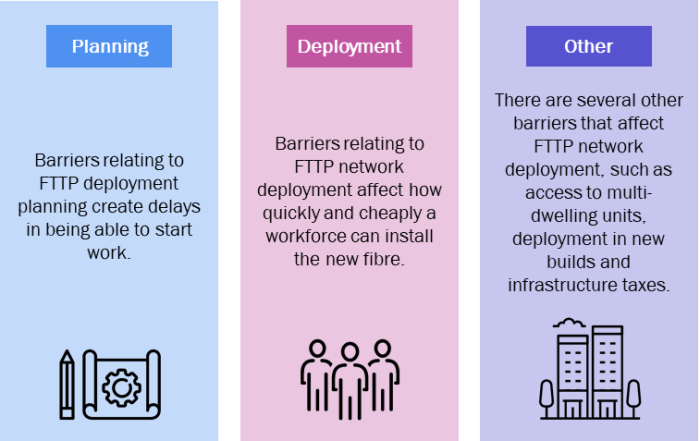Reducing barriers to FTTP deployment can save years of time and cut 30% off the cost of network roll-outs
The COVID-19 pandemic has reinforced our dependence on broadband infrastructure as an essential component of our everyday lives. Millions of people around the world have lived through lockdowns, and broadband connections have been a critical source of work and entertainment. Now, more than ever, there is a need for fast and reliable broadband infrastructure to be available on a widescale basis.
In support of this aim, operators, governments and regulators are pushing ahead with deployments of full fibre networks (also known as fibre-to-the-premises (FTTP)). Some countries are already benefitting from significant FTTP coverage, though many more still have a way to go. However, the economics of FTTP deployment are unavoidable everywhere: as networks get pushed out towards rural areas, network lengths increase, costs are driven up and commercial viability falls.
This increase in network length per premises has two effects: coverage takes longer to achieve and more costs are incurred in doing so. It is therefore important to reduce any unnecessary barriers to FTTP deployment so that coverage can be achieved as quickly and as cheaply as possible. Reducing barriers will also increase the number of premises that can be covered on a commercially viable basis, without the need for government subsidies.
Analysys Mason completed a major piece of analysis to quantify the impact (in terms of time and cost) of reducing each of the barriers to FTTP deployment in the UK. The work was completed in 2020, but the issues considered remain very relevant today. We evaluated barriers in three main categories (planning, deployment and ‘other’), as summarised in Figure 1 and below.
Figure 1: Summary of the potential barriers to FTTP deployment

Source: Analysys Mason, 2021
- Planning. Barriers relating to the planning of FTTP deployments create delays in the deployment workforce being able to start work. These delays can be caused by:
- the need to obtain permissions to begin street works (which must be sought from local authorities)
- the need to obtain permissions to access private land (which must be sought from the landowner)
- the availability of network design personnel (which must be sufficient to plan the network route in advance of the deployment).
- Deployment. Barriers relating to the deployment of FTTP networks affect how quickly and cheaply the workforce can install the new fibre. These factors are affected by:
- the availability of deployment personnel (that is, the total number of deployment personnel available in a country or region)
- the effectiveness of deployment personnel (that is, whether the personnel can use innovative deployment techniques, which may be restricted by training, availability of equipment and/or local permissions)
- the reuse of existing infrastructure (that is, the extent to which existing ducts and poles can be reused, rather than new versions of this infrastructure needing to be constructed).
- Other. There are several other barriers that are relevant to the deployment of FTTP networks, including:
- access to multi-dwelling units (which may be blocked by uncontactable landlords, even if residents request connections)
- fibre deployment in new builds (which should ideally be installed during construction, rather than needing to revisit the development)
- additional taxes on broadband infrastructure (which can have a significant impact on the commercial viability of deployments, especially in rural areas).
The impact of reducing each of these barriers varies by country, but the overall result is the same: faster coverage, lower costs and a greater proportion of the roll-out covered by the private sector. Indeed, our work shows that reducing all of the barriers listed above would result in a 6-year decrease in the total time taken to achieve 100% population coverage and an almost GBP10 billion reduction in the total deployment cost (a reduction of approximately 30%). Please see Analysys Mason’s Quantifying the impact of reducing barriers to fibre broadband for more information.
All stakeholders have a role to play in ensuring that these barriers can be reduced.
- Operators (and their network deployment subcontractors) can hire and train sufficient personnel, and can provide training in innovative deployment techniques. They can ensure that they have the personnel required to reach even the most remote areas by making firm commitments to the deployment resource supply chain.
- Governments can legislate to make deployments easier, including reducing the need for permissions, reducing taxes on infrastructure and requiring that developers meet some of the cost for connecting new-build developments. Governments can also refine the design of their subsidy schemes to ensure that subsidies are available at the same time as commercially viable premises are being covered, so that operators do not have to return to an area at a later date. Governments can also explore more-innovative financing solutions, such as state loans (which could be provided with suitable conditions).
- Regulators should promote effective reuse of existing infrastructure (including both telecoms and utility infrastructure), and ensure that wholesale prices allow a fair return to enable fibre operators to compete with each other and take their deployments as far as possible.
The reduction of barriers will help all players in the market, including both established players and new entrants. By working together, operators, governments and regulators can create a deployment environment to push full fibre networks as far as possible and bring benefits to all.
Analysys Mason has wide-ranging experience of supporting stakeholders on all sides of the fibre deployment effort. For further details and to discuss any aspect of reducing the barriers to fibre deployment, please contact Andrew Daly, Principal.
Article (PDF)
DownloadAuthor

Andrew Daly
PrincipalRelated items
Project experience
Enhancing Microsoft’s product and marketing strategy and strengthening its position as a thought leader in the SMB segment
Project experience
Using segmentation and insights from digital-native businesses to inform a global networking vendor’s sales and marketing strategy in Asia–Pacific
Project experience
Transforming a global financial management software vendor’s go-to-market strategy through advanced customer segmentation

